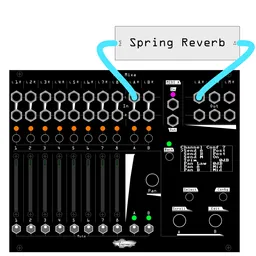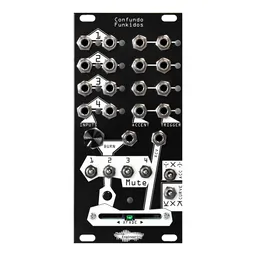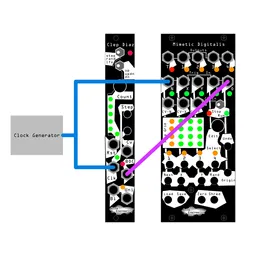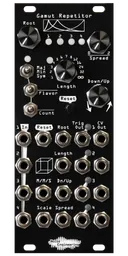I’m a big fan of 303 basslines. The distinctive slide and accent capabilities of the sequencer make for some really unique sounds.
I’m also a big fan of generative sequencing.
Now, hear me out: what if we combined those two things? It’s a crazy enough idea that it just might work! Today, we’ll be using Gamut Repetitor and a few utilities to generatively create acid patterns.
The setup: Gamut Repetitor
For this patch, Gamut Repetitor will do the heavy lifting. Gamut has two trigger modes: it can either pass triggers directly from the inputs to the outputs, or it can probabilistically generate new trigger patterns. For this patch, we’ll want to use the probabilistic mode; if you’re not already in this mode, you can switch to it by holding down the Reset button until the LEDs change.
We’ll also want a reasonably high Spread, and Down/Up in the middle, to allow for a decent range of notes in our sequence. I like using a natural minor scale, so I’ve set the switches to center, left, and right.
Of course, all settings can be set to taste, but here’s an example of how I have my Gamut set:

To get started with the patching portion, we’ll just need to send a 16th note clock to the top In jack. The rest of this patch will work best if the clock is at least 50% duty cycle.
Then, patch Trig Out 1 to the trigger input of your voice. We’ll need to modify our pitch CV signal slightly, so you can leave that unpatched for now.
Slides
For the slide component of the patch, you’ll need some sort of pitch-accurate voltage-controlled slew limiter: in our example, we’re using a Schlappi Boundary, but there are many others that will work (Make Noise Maths, anyone?). If you happen to have a gated slew module like the WMD Time Warp in your system, that will be even easier to use in this patch.
Patch CV Out 1 from Gamut into the signal input of your slew limiter. Patch the output of your slew limiter to the pitch input of your voice. Increase the rise and fall time of your slew to taste; generally, you’ll want a reasonably quick slew rate to create something similar to our inspiration, but use whatever sounds good to you.
Many voltage-controlled slews decrease slew time the higher the CV at their time controls is. This means that if we patch Trig Out 2 to the slew time CV input, notes will slide when the gate is low and jump when the gate is high.
Accents
To add some more excitement to our patch, let’s create some accents. Patch Trigger Out 3 through an attenuator, then into a timbral control on your voice – in my case, I’m patching to a CV input on my filter. Adjust the attenuator to taste; each time Out 3 goes high, our voice will have a brighter timbre.
Putting it all together
Here’s a block diagram of our patch:

This patch is a bit complex to set up, but a whole lot of fun to play. Once everything is patched, you can turn up Length all the way to continuously generate new patterns, and turn Length down to loop a pattern if you hear something you like.
Play around with Spread, Down/Up, and scale settings to create something that’s perfect for your musical goals. Try CVing Root to create chord changes if you have a loop you want to add variety to. Add some four-on-the-floor drum beats and you’ve got an instant techno generator!







